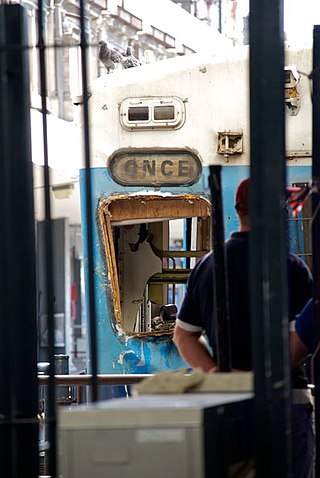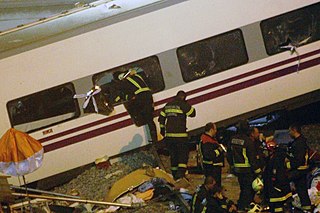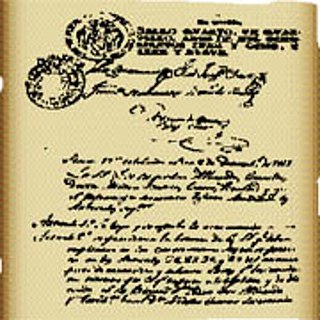
Alajuela is a province of Costa Rica. It is located in the north-central part of the country, bordering Nicaragua to the north. It also borders the provinces of Heredia to the east, San José to the south, Puntarenas to the southwest and Guanacaste to the west. As of 2011, the province had a population of 885,571. Alajuela is composed of 16 cantons, which are divided into 111 districts. It covers an area of 9,757.53 square kilometers.

Rail transport in Costa Rica is primarily under the stewardship of Incofer, an autonomous institution of the state. Incofer owns the national railway infrastructure and operates virtually all freight and passenger services, which consist primarily of commuter trains through the highly populated Central Valley. The whole Incofer network is 1,067 mm narrow gauge, although there are small tourist railways of other gauges.
The Valencia Metro derailment occurred in Valencia, Spain's third largest city, on 3 July 2006 at 1 p.m. CEST between Jesús and Plaça d'Espanya stations on the Line 1 of the Metrovalencia mass transit system. At least 43 people were killed and more than ten were seriously injured.

Alajuela is a canton in the Alajuela province of Costa Rica. Its head city is the provincial capital city of Alajuela.

Belén is the seventh canton in the Heredia province of Costa Rica. The head city is in San Antonio district. It is part of the Greater Metropolitan Area, where the housing area constitutes at least 25% of the canton's surface.

The Greater Metropolitan Area of Costa Rica is the largest urban agglomeration in the country, comprising areas of high population density surrounding the capital, San José, which geographically corresponds to the Central Valley and extended to include the Guarco Valley, where some of the cantons of the Cartago province are located.

Braulio Evaristo Carrillo Colina was the Head of State of Costa Rica during two periods: the first between 1835 and 1837, and the de facto between 1838 and 1842.
The Torre del Bierzo rail disaster occurred on 3 January 1944 near the village of Torre del Bierzo in the El Bierzo region of Spain's León province when three trains collided and caught fire inside a tunnel. Although the official death toll was 78, and at the time it was estimated to be 200–250, the most recent study has estimated it at no more than 100.

The 2012 Buenos Aires rail disaster, also known as the Once Tragedy, occurred on 22 February 2012, when a train crashed at Once Station in the Balvanera neighbourhood of Buenos Aires, Argentina.

The 2011 Flores rail crash occurred at 06.23 ART on 13 September 2011 when a bus on a level crossing at Flores railway station, in the Flores barrio of Buenos Aires, Argentina, was hit by a train on the Sarmiento Line, heading for Moreno. The accident caused that same train to collide into another one as it derailed.

The Brandsen rail disaster occurred on March 8, 1981, in Brandsen, a town in Buenos Aires Province in Argentina, when a passenger train carrying 803 passengers collided head-on with a freight train, killing 34 and injuring another 74. The train crash was caused by points failure.

The Santiago de Compostela derailment occurred on 24 July 2013, when an Alvia high-speed train traveling from Madrid to Ferrol, in the north-west of Spain, derailed at high speed on a bend about 4 kilometres (2.5 mi) outside of the railway station at Santiago de Compostela. Of the 178 people injured, the provisional number of deaths in hospital had reached 79 by the following 28 July.
The League War was the second civil war of Costa Rica, as a member state of the Federal Republic of Central America. It passed between September and October 1835 in the Central Valley of Costa Rica. Its immediate trigger was the repeal of the "Ambulance Law", the law that established the rotation of the country's capital among the four constituent cities. The most important consequence was the triumph of the city of San José over the cities of Alajuela, Heredia and Cartago, which allowed its consolidation as the capital of Costa Rica.

The Pact of Concord was the provisional Constitution of Costa Rica between 1821 and 1823, officially named the Interim Fundamental Social Pact of the Province of Costa Rica.

The Huetares are an important indigenous group of Costa Rica, who in the mid-16th century lived in the center of what is now the country. They are also mentioned with the name of güetares or pacacuas. Huetares were the most powerful and best-organized indigenous nation in Costa Rica upon the arrival of the Spaniards. During the 16th century, various chieftains dominated from the Costa Rican Atlantic coast to the Atlantic Slope. The Spanish chronicles mention a myriad of towns and the kings that ruled them, among them the Garabito Empire, located on the Central Atlantic Slope and the Tárcoles River basin, to the Virilla River and the Cordillera Central; the Kingdom of Pacaca, in the current canton of Mora, and the Lordship of el El Guarco, in the current Guarco Valley, in the Cartago Province, to the plains of the Central Caribbean and Chirripó. Their culture belonged to the Intermediate Area, and it stood out mainly for their works in stone, such as metates, sculptures, tables and ceremonial altars; and the non-practice of anthropophagy or cannibalism. Its language, the Huetar language, one of the so-called Chibcha languages, became the Lingua franca of the country. Although this language is extinct, it survives in a large number of place names in Costa Rica such as Aserrí, Tucurrique or Barva. One of the greatest enemies of the Huetares were the Nicaraos, a Nahua branch that encroached and settled on part of its territory and displaced the Huetar people that inhabited Bagaces, which resulted in tribal warfare between the Nahuas and Huetares that lasted until the arrival of the Spanish.

Interurbano Line, is a commuter railway line in Costa Rica, operated by the national public railway operator Incofer. The line connects the provinces of Alajuela, Heredia, San José and Cartago.

The 1953 Comodoro Rivadavia rail disaster occurred on February 15, 1953, in Punta Piedras, a beach resort near the city of Comodoro Rivadavia in the Patagonian province of Chubut, Argentina. It happened in the branch to Rada Tilly that extended alongside the coast, part of the Comodoro Rivadavia Railway and then operated by Ferrocarriles Argentinos.
The 1910 Costa Rica earthquakes were a series of destructive seismic events that affected Cartago, Costa Rica from 13 April to 4 May. The sequence began with a Ms 5.8 earthquake. The largest and most destructive in the sequence occurred on 4 May, measuring Ms 6.4. A total of 2,450 people were killed and the city of Cartago was severely affected.














